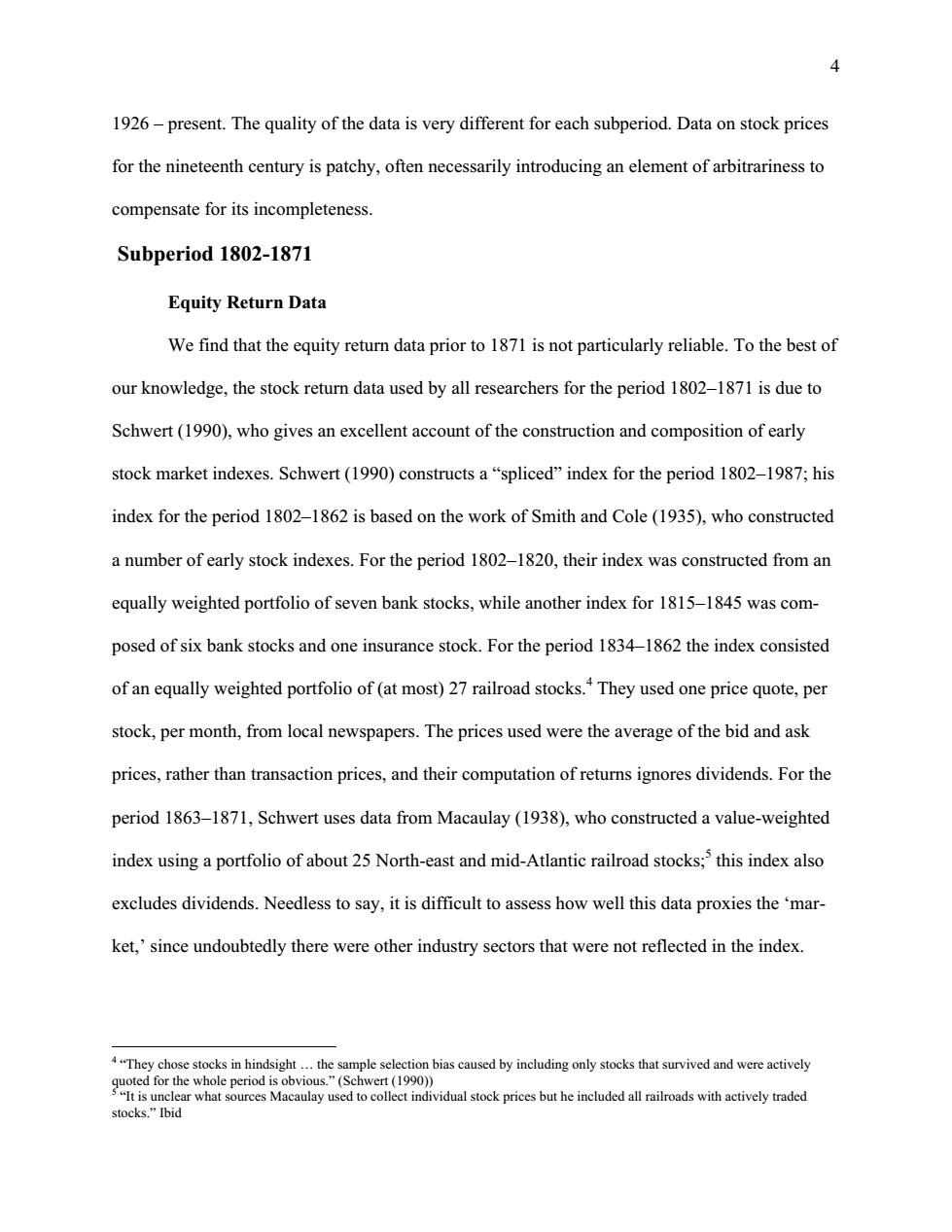正在加载图片...

4 1926-present.The quality of the data is very different for each subperiod.Data on stock prices for the nineteenth century is patchy,often necessarily introducing an element of arbitrariness to compensate for its incompleteness. Subperiod 1802-1871 Equity Return Data We find that the equity return data prior to 1871 is not particularly reliable.To the best of our knowledge,the stock return data used by all researchers for the period 1802-1871 is due to Schwert(1990),who gives an excellent account of the construction and composition of early stock market indexes.Schwert(1990)constructs a "spliced"index for the period 1802-1987;his index for the period 1802-1862 is based on the work of Smith and Cole(1935),who constructed a number of early stock indexes.For the period 1802-1820,their index was constructed from an equally weighted portfolio of seven bank stocks,while another index for 1815-1845 was com- posed of six bank stocks and one insurance stock.For the period 1834-1862 the index consisted of an equally weighted portfolio of(at most)27 railroad stocks.They used one price quote,per stock,per month,from local newspapers.The prices used were the average of the bid and ask prices,rather than transaction prices,and their computation of returns ignores dividends.For the period 1863-1871,Schwert uses data from Macaulay(1938),who constructed a value-weighted index using a portfolio of about 25 North-east and mid-Atlantic railroad stocks;this index also excludes dividends.Needless to say,it is difficult to assess how well this data proxies the 'mar- ket,'since undoubtedly there were other industry sectors that were not reflected in the index. 4They chose stocks in hindsight.the sample selection bias caused by including only stocks that survived and were actively quoted for the whole period is obvious."(Schwert(1990)) "It is unclear what sources Macaulay used to collect individual stock prices but he included all railroads with actively traded stocks.”Ibid4 1926 – present. The quality of the data is very different for each subperiod. Data on stock prices for the nineteenth century is patchy, often necessarily introducing an element of arbitrariness to compensate for its incompleteness. Subperiod 1802-1871 Equity Return Data We find that the equity return data prior to 1871 is not particularly reliable. To the best of our knowledge, the stock return data used by all researchers for the period 1802–1871 is due to Schwert (1990), who gives an excellent account of the construction and composition of early stock market indexes. Schwert (1990) constructs a “spliced” index for the period 1802–1987; his index for the period 1802–1862 is based on the work of Smith and Cole (1935), who constructed a number of early stock indexes. For the period 1802–1820, their index was constructed from an equally weighted portfolio of seven bank stocks, while another index for 1815–1845 was composed of six bank stocks and one insurance stock. For the period 1834–1862 the index consisted of an equally weighted portfolio of (at most) 27 railroad stocks.4 They used one price quote, per stock, per month, from local newspapers. The prices used were the average of the bid and ask prices, rather than transaction prices, and their computation of returns ignores dividends. For the period 1863–1871, Schwert uses data from Macaulay (1938), who constructed a value-weighted index using a portfolio of about 25 North-east and mid-Atlantic railroad stocks;5 this index also excludes dividends. Needless to say, it is difficult to assess how well this data proxies the ‘market,’ since undoubtedly there were other industry sectors that were not reflected in the index. 4 “They chose stocks in hindsight … the sample selection bias caused by including only stocks that survived and were actively quoted for the whole period is obvious.” (Schwert (1990)) 5 “It is unclear what sources Macaulay used to collect individual stock prices but he included all railroads with actively traded stocks.” Ibid